- What is Accounting?
- What Is a General Ledger?
- What are Accounts Receivable?
- Balance Sheet vs Income Statement
- What are Real Accounts?
- What is Working Capital?
- Net Sales vs Gross Sales
- Overview of Financial Controls
- Financial Accounting
- Managerial Accounting
- Cost Accounting
- Cloud Accounting
- Project Accounting
- Best Accounting Software
- Free Accounting Software
- Nonprofit Accounting Software
- Cloud-Based Accounting Software
- Billing and Invoicing Software
- Payroll Software for Small Businesses
- QuickBooks Alternatives
- QuickBooks vs FreshBooks
- QuickBooks Time Pricing
- FreshBooks Pricing
- NetSuite Pricing
- Calculate Customer Acquisition Costs
- Calculate Accumulated Depreciation
- Accounts Receivable Turnover Ratio
- Calculate Cost of Goods Manufactured
- Calculate Cost of Goods Sold
- Calculate Job Order Costing
- Debt Service Coverage Ratio
- Calculate Unit Economics

Business Cycle: Definition and 6 Stages
The economy of every country undergoes periodic fluctuations. Although they are repetitive, it is impossible to avoid them .
Many factors cause these fluctuations, such as GDP, employment, consumer spending, real income, production, and aggregate output.
Smart business owners and policymakers study these economic cycles and patterns to help them make informed financial decisions. Preparing for these periodic fluctuations ensures your business thrives even in unstable economic conditions.
This article explains the workings and stages of the business cycle.
Let’s get started.
Definition and Example of the Business Cycle
The business cycle, otherwise known as the economic cycle or trade cycle, is a term that depicts the increase or decrease in economic activities involving production, trade, and consumption over time.
In other words, a business cycle involves expansions occurring simultaneously in multiple economic activities followed by recessions (general contractions).
Business cycles help measure the downward and upward movement of the amount of productivity of businesses, employees, and consumers alongside the growth cycle of the economy over time.
As the Gross Domestic Product (GDP) fluctuates around its natural long-term growth rate, economic cycles help explain the expansion and contraction phenomena that characterize an economy over time.

Example of the Business Cycle
Every business cycle must have passed at least a single boom and a single contraction sequentially.
In recent decades, major economies and businesses have increased their production level. It has led to the need for more employees and has translated to less spending money. As a result, companies make more profits that help them focus on growth.
In the reverse case, when the economy is slow, there is a decline in the number of employees needed, which translates to a decrease in consumer spending. As a result, companies have less focus on growth.
To fully understand the business cycle, you need to understand two key terms: economic expansion and contraction.
Economic expansion in economic analysis is the rate at which production and consumption change positively, while economic contraction is inversely the rate at which production and consumption change negatively.
The United States as a Case Study
In the United States, for example, the end and start of a business cycle are defined and measured by the National Bureau of Economic Research (NBER), a non-profit business cycle dating committee.
The NBER uses quarterly GDP growth rates to determine the current business or economic cycle. It waits till it gets enough economic data to prevent a situation where it would have to make revisions to the business cycle chronology.
Businesses are affected by the expansion and contraction of the economy as they also go through their own distinct set of ups and downs in their trade cycle.
This situation puts the management of the business in a position to devise strategic financial decisions to deal with these challenges head-on. Understanding the time of the business cycle helps businesses make correct investment decisions.
6 Stages of the Business Cycle
The business cycle illustrates how a nation's aggregate economy moves over time, showing ups and downs.
Business cycles are characterized by economic expansions followed by sustained periods of economic recessions. In a business cycle diagram, the straight line is the steady growth line, and every business cycle moves about the line.

All business cycles pass through six distinct identical phases.
1. Expansion Stage
The first stage in every business cycle is the expansion phase. Expansion begins when there is a visible increase in positive economic indicators such as employment, demand, and supply of goods and services, wages, profits, personal income, national income, and output.
Economic expansion is a period of relative growth in a nation's economy. During this phase, productivity increases, as visible as an upward movement in the yield curve.
The economic recovery phase is another name for the expansion stage. It occurs after an economy has been through a contraction for an extended period.
This phase is characterized by debtors paying off their debts on time, high velocity of money supply, and high investments. It continues as long as the economic conditions remain favorable.
GDP growth is the economic measurement index that indicates economic output increase during the expansion phase. When economic output rises, businesses and organizations hire more workers and open up more strategic business units .
The goal of the federal reserve bank during the expansion phase is to keep inflation around 2% for a healthy economy.
During this stage, the stock market also experiences rising prices as investors grow in confidence, businesses receive more funding, and consumer confidence is at an all-time high.
The expansion phase is close to its end or overheating state when the economy begins to grow too fast, which is visible in the employment rate emerging below the natural rate and inflation increasing with stock prices rising to the point of being overvalued.
A country experiences a healthy expansion when the GDP growth rate is in the 2 – 3% range, inflation maintains its 2% target, and the unemployment rate is between 3.5 – 4.5%, with the stock market supporting a bullish run.
2. Peak Stage
The saturation point or peak an economy reaches is the second stage of the business cycle. It is visible by the economic indicator's inability to grow further as it has attained its maximum growth limit.
During the peak phase, prices are at their highest, marking the reversal point in the trend of economic growth as consumers tend to make changes to their budget structure.
At the peak phase, all expansionary indicators begin to level as the economy prepares to transition into the contraction or recession phase.
The peak is visible graphically as the highest portion of the yield curve before the economy begins to experience a downward spiral characterized by a continuous decline in GDP growth below the 2% healthy mark.
Once the nation's economic numbers start growing out of their healthy ranges, the economy is most vulnerable as any factors can throw it off balance at this stage.
Companies expanding recklessly, overconfident investors, buying up of assets, and a significant price increase not supported by their underlying value are several factors that can throw the country's economy off balance in the peak stage.
With no room left for growth and nowhere to go but down, the economy falls into the recession or contraction phase after it has reached the peak and end of the expansion phase. It indicates that prices and production have reached their respective limits.
3. Recession or Contraction Stage
The recession stage comes after the peak phase and is evident by a rapid and steady decline in the demand for goods and services.
Producers in the economy do not readily notice this rapid and steady decline as they go about their regular daily production numbers. Thus creating a situation of excess supply in the market which tends to bring down prices abruptly.
Apart from prices, other positive economic indicators also witness a significant fall, such as income, wages, and output.
A recession graphically spans the time from the peak to the trough, as it is the period when economic activity is at its lowest.
During the recession, unemployment numbers rise, the stock market enters a bearish trend, and the GDP growth is below the 2% healthy value, forcing businesses to cut back on their economic activities.
For an economy to be in recession, the GDP has to have shown a significant decline for two consecutive quarters. It does not return to its original shape and size immediately after the recession phase is over.
4. Depression Stage
After the contraction phase, the nation's economy experiences a significant rise in unemployment across all facets of the economy.
Besides the increase in unemployment, there is also a decline in the growth index for the country's economy, as is evident in its fall below the steady growth line. At this stage of the nation's economy, the country is in its depression stage.
5. Trough Stage
The trough stage is the fifth phase of the business cycle. It is characterized by a decrease in the rate of adverse change in the nation's declining GDP until it eventually turns positive.
In economic terms, a trough represents the negative saturation point for an economy as there is an extensive depletion of national income and expenditure during this stage of the business cycle.
This phase begins when the nation's economy transitions from its contraction phase into its expansion and is represented graphically as the lowest point of the yield curve.
The rebound experienced during the trough phase is not always straight or quick as it continues steadily until the economy reaches full economic recovery.
6. Recovery Stage
After the through phase, a nation's economy enters the recovery stage. This stage is characterized by a significant turnaround in the country's economy, evident by its recovery from its negative growth rate.
Due to prices at their lowest point, demand starts to witness an increase. Consequently, supply and industrial production increase as the population's attitude toward investment and employment is now positive.
During the recovery phase, employment also begins to rise as the accumulated cash balances with the bankers make lending show positives.
Depreciated capital is readily replaced, providing unique opportunities for investment in the production process, which continues until the nation's economy returns to steady growth.
Economic Indicators for Measuring the Business Cycle
Economic indicators used to measure the productivity of a business cycle are very extensive as they are based on financial data of the nation's economy.
Here are the three common categories of economic business cycle indicators.
1. Leading Business Cycle Indicators
A leading business cycle indicator measures aggregate economic activity and predict a business cycle's beginning phase.
The leading business cycle indicators are the average weekly work hours in manufacturing, stock prices, factory orders of goods, index of customer expectations, average weekly claims for unemployment insurance, interest rate spread, and housing permits.
Usually, changing these indicator metrics could significantly point towards a potential shift in the business cycle. Leading economic cycle indicators get the most attention due to their tendency to predict a shift in advance of a business cycle.
These indicators work best alongside coincident and lagging indicators in the same framework. They provide a more thorough understanding of the true nature of economic activity.
2. Lagging Business Cycle Indicators
Lagging economic cycle indicators are designed as confirmatory indicators, confirming the trends predicted by leading indicators. Generally, lagging indicators usually experience a significant shift witnessed after an economy has entered a period of fluctuation.
The average length of employment, labor cost per unit of manufacturing output, consumer price index, commercial lending activity, and average prime rate are all lagging indicators components.
3. Coincident Business Cycle Indicators
Coincidental economic cycle indicators measure the aggregate economic activity that is subject to changes as the business cycle progresses.
As one of the three components of economic business cycle indicators, coincident cycle indicators are economic research tools that help measure the real income of consumers in the market, among other factors.
The unemployment rate, personal finance levels, and industrial production are index components for coincident business cycle indicators.
How is the Business Cycle Influenced?
The fact that periodic business cycles move in phases does not mean they cannot be influenced. Countries can manage the various stages of a business cycle through monetary and fiscal policies.
1. Government Legislations
Generally, the government monitors the business cycle and devises a series of legislations to influence their country's business cycle, primarily around changes in tax and spending.
The government's fiscal policy is designed to increase taxes and reduce spending during an economic expansion, lower taxes and increase spending during an economic contraction. This policy is called the expansionary fiscal policy.
2. Monetary Policy
The Fed and the country's central bank use monetary policy tools that help implement needed changes to the country's interest rates.
This policy helps curtain lending and borrowing by businesses, banks, and consumers and influences the business cycle through rates that target inflation and unemployment.
When the country has slipped from its expansionary phase into a contraction phase, the central bank lowers its target interest rates to encourage borrowing in a request to end the contraction phase.
This policy by the central bank is termed an expansionary monetary policy. It is configured to be the turning point that pushes the business cycle back into the expansionary phase.
In unique situations, when a country's economy is growing faster than the country can afford, the central bank of such a country steps in. It offers preventive measures to contain the fast-growing economy.
The nation's central bank raises its target interest rates to discourage borrowing and spending, curbing the growth of the nation's economy.
This policy by the central bank is termed a contractionary monetary policy as its main aim is to contract economic activity spread and economic output to contain the economic expansion.
Business Cycle FAQ
No defined time frame exists for how long a business cycle should last. It varies from being short for months to being long, lasting several years. According to the U.S Government National Bureau of Economic Research, the time frame average for business cycles in America to play out is around five and a half years since World War II. Periods of expansion are generally more prolonged than those of contractions. As observed since WWII by the Congressional Research Service, the economic expansion period lasted 65 months on average, while the financial contraction period lasted about 11 months in the U.S.
Ranging from technological innovations to wars, a wide variety of factors can shape the business cycle. According to the Congressional Research Service, the critical influence remains on aggregate demand and aggregate supply within an economy. Contraction occurs when demand decreases and when demand increases, expansion occurs.
The economic expansion that occurred between 2009-2020 in the U.S went down in history as the longest expansion and the latest for a record 128 months. The U.S reached the peak of this longest expansion in February 2020. It was characterized by many variables in an economy fluctuating over time, leading to a shift in economic and non-economic factors.
Was This Article Helpful?
Martin luenendonk.
Martin loves entrepreneurship and has helped dozens of entrepreneurs by validating the business idea, finding scalable customer acquisition channels, and building a data-driven organization. During his time working in investment banking, tech startups, and industry-leading companies he gained extensive knowledge in using different software tools to optimize business processes.
This insights and his love for researching SaaS products enables him to provide in-depth, fact-based software reviews to enable software buyers make better decisions.
- Search Search Please fill out this field.
What Is a Business Cycle?
- How It Works
- Measuring and Dating
- Relationship With Stock Prices
The Bottom Line
Business cycle: what it is, how to measure it, and its 4 phases.
:max_bytes(150000):strip_icc():format(webp)/headshot1-6c67c442a0684de18fb605c3cd2fb176.png)
- Depression in the Economy: Definition and Example
- Economic Collapse
- Business Cycle CURRENT ARTICLE
- Boom And Bust Cycle
- Negative Growth
- What Was the Great Depression?
- Were There Any Periods of Major Deflation in U.S. History?
- The Greatest Generation
- U.S. Government Financial Bailouts
- Austerity: When the Government Tightens Its Belt
- The New Deal
- The Economic Effects of the New Deal
- Gold Reserve Act of 1934
- Emergency Banking Act of 1933
Madelyn Goodnight / Investopedia
Business cycles are a type of fluctuation found in the aggregate economic activity of a nation—a cycle that consists of expansions occurring at about the same time in many economic activities, followed by similarly general contractions. This sequence of changes is recurrent but not periodic.
The business cycle is also called the economic cycle .
Key Takeaways
- Business cycles are composed of concerted cyclical upswings and downswings in the broad measures of economic activity—output, employment, income, and sales.
- The alternating phases of the business cycle are expansions and contractions.
- Contractions often lead to recessions, but the entire phase isn't always a recession.
- Recessions often start at the peak of the business cycle—when an expansion ends—and end at the trough of the business cycle, when the next expansion begins.
- The severity of a recession is measured by the three Ds: depth, diffusion, and duration.
Understanding the Business Cycle
In essence, business cycles are marked by the alternation of the phases of expansion and contraction in aggregate economic activity and the co-movement among economic variables in each phase of the cycle.
Aggregate economic activity is represented by not only real (i.e., inflation-adjusted) GDP —a measure of aggregate output—but also the aggregate measures of industrial production, employment, income, and sales, which are the key coincident economic indicators used for the official determination of U.S. business cycle peak and trough dates.
Popular misconceptions are that the contractionary phase is a recession and that two consecutive quarters of decline in real GDP (an informal rule of thumb) means a recession.
It's important to note that recessions occur during contractions but are not always the entire contractionary phase. Also, consecutive declines in real GDP are one of the indicators used by the NBER, but it is not the definition the organization uses to determine recessionary periods.
On the flip side, a business cycle recovery begins when that recessionary vicious cycle reverses and becomes a virtuous cycle, with rising output triggering job gains, rising incomes, and increasing sales that feedback into a further rise in output .
The recovery can persist and result in a sustained economic expansion only if it becomes self-feeding, which is ensured by this domino effect driving the diffusion of the revival across the economy.
Of course, the stock market is not the economy. Therefore, the business cycle should not be confused with market cycles , which are measured using broad stock price indices.
Measuring and Dating Business Cycles
The severity of a recession is measured by the three D's: depth, diffusion, and duration. A recession's depth is determined by the magnitude of the peak-to-trough decline in the broad measures of output, employment, income, and sales.
Its diffusion is measured by the extent of its spread across economic activities, industries, and geographical regions. Its duration is determined by the time interval between the peak and the trough.
An expansion begins at the trough (or bottom) of a business cycle and continues until the next peak, while a recession starts at that peak and continues until the following trough.
The National Bureau of Economic Research (NBER) determines the business cycle chronology—the start and end dates of recessions and expansions for the United States.
Accordingly, its Business Cycle Dating Committee considers a recession to be "a significant decline in economic activity spread across the economy, lasting more than a few months, normally visible in real GDP, real income, employment, industrial production, and wholesale-retail sales."
The Great Depression featured many recessions, one of which lasted for 44 months.
The Dating Committee typically determines recession start and end dates long after the fact. For instance, after the end of the 2007–09 recession, it "waited to make its decision until revisions in the National Income and Product Accounts [were] released on July 30 and Aug. 27, 2010," and announced the June 2009 recession end date on Sept. 20, 2010.
U.S. expansions have lasted longer than U.S. contractions on average. Between 1945 and 2019, the average expansion lasted about 65 months. The average recession lasted approximately 11 months.
Between the 1850s and World War II, the average expansion lasted about 26 months and the average recession about 21 months. The longest expansion was from 2009 to 2020, which lasted 128 months.
Stock Prices and the Business Cycle
The biggest stock price downturns tend to occur—but not always—around business cycle downturns (e.g., contractions and recessions). For example, the Dow Jones Industrial Average and the S&P 500 took steep dives during the Great Recession. The Dow fell 51.1%, and the S&P 500 fell 56.8% between Oct. 9, 2007 to March 9, 2009.
There are many reasons for this, but primarily, it is because businesses assume defensive measures and investor confidence falls during contractionary periods. Many events occur before people in an economy are aware they are in a contraction, but the stock market trails what is going on in the economy.
So, if there is speculation or rumors about a recession, mass layoffs , rising unemployment, decreasing output, or other indications, businesses and investors begin to fear a recession and act accordingly. Businesses assume defensive tactics, reducing their workforces and budgeting for an environment of falling revenues.
Investors flee to investments "known" to preserve capital, demand for expansionary investments falls, and stock prices drop.
It's important to remember that while stock prices tend to fall during economic contractions, the phase does not cause stock prices to fall—fear of a recession causes them to fall.
What Are the Stages of the Business Cycle?
In general, the business cycle consists of four distinct phases: expansion, peak, contraction, and trough.
What Does a Business Cycle Describe?
A business cycle describes the fluctuations in an economy over a period of time, generally the period from the start of one recession to the start of the next. This would include periods when the economy grows.
Are Business Cycles Predictable?
Generally, business cycles are not predictable. Economies are complex machines that function in a variety of ways and are intertwined in as many ways. The ability to predict how they will move is extremely difficult. There can be signs of changes in an economy, such as changes in inflation and production, but to predict an all-out change in the business cycle is very tough if not impossible.
The business cycle is the time it takes the economy to go through all four phases of the cycle: expansion, peak, contraction, and trough. Expansions are times of increasing profits for businesses, and rising economic output, and are the phase the U.S. economy spends the most time in. Contractions are times of decreasing profits and lower output and are the phase in which the least amount of time is spent.
Federal Reserve Bank of St. Louis. " All About the Business Cycle: Where Do Recessions Come From? "
The National Bureau of Economic Research. " Business Cycle Dating ."
National Bureau of Economic Research. " The NBER's Recession Dating Procedure ."
Congressional Research Service. " Introduction to U.S. Economy: The Business Cycle and Growth ," Page 1.
National Bureau of Economic Research. " Business Cycle Dating Committee, National Bureau of Economic Research ."
Congressional Research Service. " Introduction to U.S. Economy: The Business Cycle and Growth ," Page 2.
Federal Reserve Bank of Atlanta. " Stock Prices in the Financial Crisis ."
:max_bytes(150000):strip_icc():format(webp)/GettyImages-1210182430-f3155aa2fe15423389e654e2524226e2.jpg)
- Terms of Service
- Editorial Policy
- Privacy Policy
Check your browser settings and network. This website requires JavaScript for some content and functionality.
Learning Activities
This series provides a range of activities that can be used in the classroom to help students build different skills through meaningful learning experiences.
Reading and Interpreting Charts
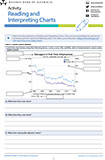
Provides questions and activities linked to the Reading and Interpreting Charts video .
Download 859 KB
The Future of Work
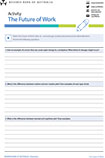
Provides comprehension questions linked to the Future of Work video .
Download 45 KB
Opening the Vault
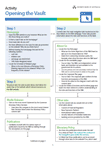
Guides students through how to find the information they need on the RBA website.
Download 146 KB
Unpacking Publications
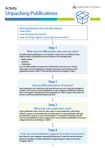
Helps students familiarise themselves with RBA publications and provides some tips to make the most of the information provided.
Download 134 KB
Read and Rehash
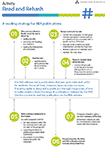
Guides students through how to make the most of RBA publications.
Download 376 KB

Key Economic Indicators – Unpacking the Snapshot
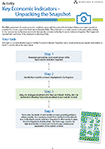
Helps students to apply skills to summarise and explain key economic statistics and trends.
Download 195 KB
The Transmission Mechanism
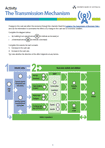
Helps students understand how a change in monetary policy flows through to the rest of the economy.
Download 148 KB
Exploring Inflation
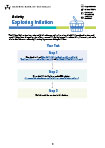
Work through this Activity to investigate interesting examples of inflation developments and trends.
Download 138 KB
You Make the Decision – the Cash Rate
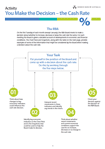
Helps students identify key economic indicators and how recent movements in these indicators could influence the cash rate decision.
Download 126 KB
Perspectives on RBA decisions
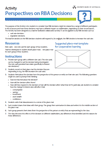
Helps students to consider how decisions made by the RBA might affect different people in the economy.
Download 135 KB
Building Charts Using RBA Statistical Tables
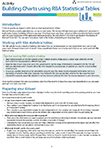
Helps students to gain confidence building Excel charts from data available on the RBA website.
Download 462 KB
Sectors in the Economy
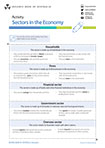
Helps students understand the five sectors of the circular flow model
Download 109 KB
Complete the Circular Flow Model

Provides an outline of the circular flow model for students to label
Download 101 KB
Injections and Leakages
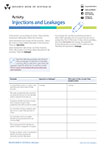
Helps students identify different economic activity as injections or leakages
Download 144 KB
Business Cycle Case Studies
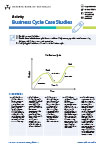
Help students consider how different people might be affected by the business cycle
Download 107 KB
Analysing Australia's Economic Performance
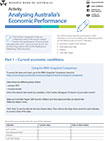
Helps students explore economic growth (GDP growth), unemployment rate, inflation and the cash rate
Comparing the Australian and Indian Economies
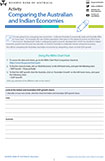
Helps students compare charts on GDP growth for Australia and India
Download 113 KB
A Survey on Business Cycles: History, Theory and Empirical Findings
- Conference paper
- First Online: 14 April 2023
- Cite this conference paper

- Giuseppe Orlando ORCID: orcid.org/0000-0003-2630-5403 5 , 6 &
- Mario Sportelli ORCID: orcid.org/0000-0003-1999-7632 6
Part of the book series: Springer Proceedings in Business and Economics ((SPBE))
Included in the following conference series:
- X Euro-Asian Symposium on Economic Theory "Viability of Economic Theories: through Order and Chaos"
215 Accesses
1 Citations
This work summarizes recent advances in modelling and econometrics for alternative directions in macroeconomics and cycle theories. Starting from the definition of a cycle and continuing with a historical overview, some basic nonlinear models of the business cycle are introduced. Furthermore, some dynamic stochastic models of general equilibrium (DSGE) and autoregressive models are considered. Advances are then provided in recent applications to economics such as recurrence quantification analysis and numerical tools borrowed from other scientific fields such as physics and engineering. The aim is to embolden interdisciplinary research in the direction of the study of business cycles and related control techniques to broaden the tools available to policymakers.
This is a preview of subscription content, log in via an institution to check access.
Access this chapter
Subscribe and save.
- Get 10 units per month
- Download Article/Chapter or eBook
- 1 Unit = 1 Article or 1 Chapter
- Cancel anytime
- Available as PDF
- Read on any device
- Instant download
- Own it forever
- Available as EPUB and PDF
- Compact, lightweight edition
- Dispatched in 3 to 5 business days
- Free shipping worldwide - see info
- Durable hardcover edition
Tax calculation will be finalised at checkout
Purchases are for personal use only
Institutional subscriptions
Similar content being viewed by others

On Business Cycles and Growth

Business Cycles
Adachi, M. (1993). Embeddings and immersions . American Mathematical Society.
Google Scholar
Anisiu, M.-C. (2014). Lotka, Volterra and their model. Didáctica Mathematica, 32 , 9–17.
Araujo, R. A., & Moreira, H. N. (2021). Testing a Goodwin’s model with capacity utilization to the US economy. In G. Orlando, A. Pisarchik, & R. Stoop (Eds.), Nonlinearities in economics (pp. 295–313). Springer.
Chapter Google Scholar
Bastos, J., & Caiado, J. (2011). Recurrence quantification analysis of global stock. Physica A-Statistical Mechanics and Its Applications , 390 .
Brock, W. A., & Dechert, W. D. (1991). Non-linear dynamical systems: Instability and chaos in economics. In W. Hildenbrand & H. Sonnenschein (Eds.), Handbook of mathematical economics (vol. 4, pp. 2209–2235).
Buizza, R. (2018). Ensemble forecasting and the need for calibration. Statistical postprocessing of ensemble forecasts (pp. 15–48). Elsevier.
Chen, P., & Semmler, W. (2021). Financial stress, regime switching and macrodynamics. In G. Orlando, A. N. Pisarchik, & R. Stoop (Eds.), Nonlinearities in economics: An interdisciplinary approach to economic dynamics, growth and cycles (pp. 315–335). Springer International Publishing.
Chiarella, C., Flaschel, P., Groh, G., & Semmler, W. (2013). Disequilibrium, growth and labor market dynamics: Macro perspectives . Springer Science & Business Media.
Chiarella, C., & Flaschel, P. (1996). Real and monetary cycles in models of Keynes-Wicksell type. Journal of Economic Behavior & Organization, 30 (3), 327–351.
Article Google Scholar
Claessens, S., Kose, M. A., & Terrones, M. E. (2021). Financial cycles: What? How? When? NBER International Seminar on Macroeconomics .
Crowley, P. M. (2008). Analyzing convergence and synchronicity of business and growth cycles in the euro area using cross recurrence plots. The European Physical Journal Special Topics, 164 (1), 67–84.
Day, R. H. (1994). Complex economic dynamics: An introduction to macroeconomic dynamics (vol. 2). MIT Press.
Eckmann, J.-P., Kamphorst, S. O., & Ruelle, D. (1987). Recurrence plots of dynamical systems. EPL (Europhysics Letters) , 4 (9), 973.
Fabretti, A., & Ausloos, M. (2005). Recurrence plot and recurrence quantification analysis techniques for detecting a critical regime. examples from financial market indices. International Journal of Modern Physics C , 16 (05), 671–706.
Fanti, L. (2003). Labour contract length, stabilisation and the growth cycle. Rivista internazionale di scienze sociali , pp. 1000–1024.
Giacomini, R. (2013). The relationship between DSGE and VAR models. VAR models in macroeconomics–new developments and applications: Essays in honor of Christopher A. Sims .
Ginoux, J.-M., & Letellier, C. (2012). Van der Pol and the history of relaxation oscillations: Toward the emergence of a concept. Chaos: An Interdisciplinary Journal of Nonlinear Science , 22 (2), 023120.
Gonze, D., & Ruoff, P. (2021). The Goodwin oscillator and its legacy. Acta Biotheoretica, 69 (4), 857–874.
Goodwin, R. M. (1982). A growth cycle. essays in economic dynamics (pp. 165–170). Palgrave Macmillan.
Goodwin, R. M. (1951). The nonlinear accelerator and the persistence of business cycles. Econometrica: Journal of the Econometric Society , 1–17.
Gorban, A. N., Smirnova, E. V., & Tyukina, T. A. (2010). Correlations, risk and crisis: From physiology to finance. Physica A: Statistical Mechanics and Its Applications, 389 (16), 3193–3217.
Haddad, E. A., Cotarelli, N., Simonato, T. C., Vale, V. A., & Visentin, J. C. (2020). The grand tour: Keynes and Goodwin go to Greece. Economic Structures, 9 (1), 1–21.
Harding, D., & Pagan, A. (2002). Dissecting the cycle: A methodological investigation. Journal of Monetary Economics, 49 (2), 365–381.
Hicks, J. R. (1946). Value and capital: An inquiry into some fundamental principles of economic theory . Clarendon Press.
Jevons, W. S. (1879). The theory of political economy . Macmillan and Company.
Jouan, G., Cuzol, A., Monbet, V., & Monnier, G. (2022). Gaussian mixture models for clustering and calibration of ensemble weather forecasts. Discrete and Continuous Dynamical Systems - S . https://doi.org/10.3934/dcdss.2022037
Kalecki, M. (1971). Selected essays on the dynamics of the capitalist economy 1933–1970 . Cambridge University Press.
Keynes, J. M. (1936). 1973, the general theory of employment, interest, and money (vol. 7). Macmillan for the Royal Economic Society.
Kousik, G., Basabi, B., & Chowdhury, A. R. (2010). Using recurrence plot analysis to distinguish between endogenous and exogenous stock market crashes. Physica a: Statistical Mechanics and Its Applications, 389 (9), 1874–1882.
Kuznets, S. (1930). Static and dynamic economics. The American Economic Review, 20 (3), 426–441.
Lampart, M., Lampartová, A., & Orlando, G. (2022). On extensive dynamics of a Cournot heterogeneous model with optimal response. Chaos: An Interdisciplinary Journal of Nonlinear Science , 32 (2), 023124.
Le Corbeiller, P. (1933). Les systèmes autoentretenus et les oscillations de relaxation. Econometrica: Journal of the Econometric Society , 1 , 328–332.
Letellier, C., & Rossler, O. E. (2006). Rossler attractor. Scholarpedia, 1 (10), 1721.
Li, T., & Yorke, J. A. (1975). Period three implies chaos. American Mathematical Monthly , 82 , 985–992.
Liénard, A. (1928). Etude des oscillations entretenues. Revue Générale De L’électricité, 26 , 901–912.
Lorenz, E. N. (1963). Deterministic nonperiodic flow. Journal of Atmospheric Sciences, 20 , 130–141.
Lorenz, H.-W. (1992). Complex dynamics in low-dimensional continuous-time business cycle models: The Šil nikov case. System Dynamics Review, 8 (3), 233–250.
Lorenz, H. W. (1993). Nonlinear dynamical economics and chaotic motion . Springer Verlag.
Lowe, A. (2017). On economic knowledge: Toward a science of political economics . Routledge.
Book Google Scholar
Mackey, M. C., & Glass, L. (1977). Oscillation and chaos in physiological control systems. Science, 197 (4300), 287–289.
Marx, K., & McLellan, D. (2008). Capital: An abridged edition . Oxford University Press.
May, R. M. (1976). Simple mathematical models with very complicated dynamics. Nature, 261 (5560), 459–467.
May, R. M. (2004). Simple mathematical models with very complicated dynamics . In: B. R. Hunt, T. Y. Li, J. A. Kennedy & H. E. Nusse (Eds.), The theory of chaotic attractors . Springer. https://doi.org/10.1007/978-0-387-21830-4_7
Metzler, L. A. (1941). The nature and stability of inventory cycles on JSTOR. Review of Economics and Statistics, 23 (3), 113–129.
Mill, J. S. (1848). Principles of political economy with some of their applications to social philosoph y. John W. Parker.
Mittnik, S., & Semmler, W. (2012). Regime dependence of the fiscal multiplier. Journal of Economic Behavior & Organization, 83 (3), 502–522.
OECD. (2016). Quarterly GDP (indicator). https://doi.org/10.1787/b86d1fc8-en
Orlando, G. (2016). A discrete mathematical model for chaotic dynamics in economics: Kaldor’s model on business cycle. Mathematics and Computers in Simulation, 125 , 83–98.
Orlando, G. (2022). Simulating heterogeneous corporate dynamics via the Rulkov map. Structural Change and Economic Dynamics, 61 , 32–42.
Orlando, G., & Bufalo, M. (2022). Modelling bursts and chaos regularization in credit risk with a deterministic nonlinear model. Finance Research Letters, 47 , 102599.
Orlando, G., & Della Rossa, F. (2019). An empirical test on Harrod’s open economy dynamics. Mathematics, 7 (6), 524.
Orlando, G., & Sportelli, M. (2021). Growth and cycles as a struggle: Lotka-Volterra, Goodwin and Phillips. In G. Orlando, A. Pisarchik, & R. Stoop (Eds.), Nonlinearities in economics (pp. 191–208). Springer.
Orlando, G., & Taglialatela, G. (2021a). An example of nonlinear dynamical system: The logistic map. In G. Orlando, A. Pisarchik, & R. Stoop (Eds.), Nonlinearities in economics (pp. 39–50). Springer.
Orlando, G., & Taglialatela, G. (2021b). Dynamical systems. In G. Orlando, A. N. Pisarchik, & R. Stoop (Eds.), Nonlinearities in economics: An interdisciplinary approach to economic dynamics, growth and cycles (pp. 13–37). Springer International Publishing.
Orlando, G., & Zimatore, G. (2017). RQA correlations on real business cycles time series. Proceedings of the Conference on Perspectives in Nonlinear Dynamics, 2016 (1), 35–41.
Orlando, G., & Zimatore, G. (2018). Recurrence quantification analysis of business cycles. Chaos, Solitons & Fractals, 110 , 82–94.
Orlando, G., & Zimatore, G. (2020b). Recurrence quantification analysis on a Kaldorian business cycle model. Nonlinear Dynamics, 100 (1), 785–801.
Orlando, G., & Zimatore, G. (2021). Recurrence quantification analysis of business cycles. In G. Orlando, A. Pisarchik, & R. Stoop (Eds.), Nonlinearities in economics (pp. 269–282). Springer.
Orlando, G., Pisarchik, A. N., & Stoop, R. (Eds.). (2021a). Nonlinearities in economics: An interdisciplinary approach to economic dynamics, growth and cycles . Springer International Publishing.
Orlando, G., Stoop, R., & Taglialatela, G. (2021b). Bifurcations. In G. Orlando, A. Pisarchik, & R. Stoop (Eds.), Nonlinearities in economics (pp. 51–72). Springer.
Orlando, G., Stoop, R., & Taglialatela, G. (2021c). Chaos. In G. Orlando, A. Pisarchik, & R. Stoop (Eds.), Nonlinearities in economics (pp. 87–103). Springer.
Orlando, G., Stoop, R., & Taglialatela, G. (2021d). Embedding dimension and mutual information. In G. Orlando, A. Pisarchik, & R. Stoop (Eds.), Nonlinearities in economics (pp. 105–108). Springer.
Orlando, G., Zimatore, G., & Giuliani, A. (2021e). Recurrence quantification analysis: Theory and applications. In G. Orlando, A. Pisarchik, & R. Stoop (Eds.), Nonlinearities in economics (pp. 141–150). Springer.
Orlando, G., Bufalo, M., & Stoop, R. (2022). Financial markets’ deterministic aspects modeled by a low-dimensional equation. Science and Reports, 12 (1693), 1–13.
Orlando, G., & Zimatore, G. (2020a). Business cycle modeling between financial crises and black swans: Ornstein–Uhlenbeck stochastic process vs Kaldor deterministic chaotic model. Chaos: An Interdisciplinary Journal of Nonlinear Science , 30 (8), 083129.
Orlando, G. (2018). Chaotic business cycles within a Kaldor-Kalecki framework . In: Pham, V. T., Vaidyanathan, S., Volos, C., Kapitaniak, T. (eds.). Nonlinear dynamical systems with self-excited and hidden attractors. Studies in systems, decision and control, vol. 133. Springer. https://doi.org/10.1007/978-3-319-71243-7_6
Piscitelli, L., & Sportelli, M. C. (2004). A simple growth-cycle model displaying “Sil’nikov Chaos.” Economic complexity (Vol. 14, pp. 3–30). Emerald Group Publishing Limited.
Prescott, E. C. (1986). Theory ahead of business-cycle measurement. In Carnegie-Rochester conference series on public policy (vol. 25, pp. 11–44). Elsevier.
Rivot, S., & Trautwein, H.-M. (2020). Macroeconomic statics and dynamics in a historical perspective. European Journal of the History of Economic Thought, 27 (4), 471–475.
Della Rossa, F., Guerrero, J., Orlando, G., & Taglialatela, G. (2021). Applied spectral analysis. In G. Orlando, A. Pisarchik, & R. Stoop (Eds.), Nonlinearities in economics (pp. 123–139). Springer.
Rosser, J. B., Jr. (2013). A conceptual history of economic dynamics . Madison University.
Rössler, O. E. (1976). An equation for continuous chaos. Physics Letters A, 57 (5), 397–398.
Semmler, W. (1986). On nonlinear theories of economic cycles and the persistence of business cycles. Mathematical Social Sciences, 12 (1), 47–76.
Sharkovskij, A. (1964). Co-existence of cycles of a continuous map of the line into itself. Ukranian Math. Z., 16 , 61–71.
Sherman, H. J. (2014). The business cycle: Growth and crisis under capitalism . Princeton University Press.
Slutzky, E. (1937). The summation of random causes as the source of cyclic processes. Econometrica: Journal of the Econometric Society , 5 (2), 105–146.
Sportelli, M. C. (2000). Dynamic complexity in a Keynesian growth-cycle model involving Harrod’s instability. Zeitschr. f. Nationalökonomie., 71 (2), 167–198.
Sportelli, M., & De Cesare, L. (2019). Fiscal policy delays and the classical growth cycle. Applied Mathematics and Computation, 354 , 9–31.
Stiglitz, J. E. (2018). Where modern macroeconomics went wrong. Oxford Review of Economic Policy, 34 (1–2), 70–106.
Stoop, R. (2021). Signal processing . In G. Orlando, A. N. Pisarchik & R. Stoop (Eds.), Nonlinearities in economics. Dynamic modeling and econometrics in economics and finance (vol. 29). Springer. https://doi.org/10.1007/978-3-030-70982-2_8
Taillardat, M., Mestre, O., Zamo, M., & Naveau, P. (2016). Calibrated ensemble forecasts using quantile regression forests and ensemble model output statistics. Monthly Weather Review, 144 (6), 2375–2393.
Veblen, T. (1904). The theory of business enterprise . Charles Scribner’s Sons.
Verhulst, P. (1847). Deuxième mémoire sur la loi d’accroissement de la population. Mémoires De L’académie Royale Des Sciences, Des Lettres Et Des Beaux-Arts De Belgique, 20 , 1–32.
Wang, K., Steyn-Ross, M. L., Steyn-Ross, D. A., Wilson, M. T., Sleigh, J. W., & Shiraishi, Y. (2014). Simulations of pattern dynamics for reaction-diffusion systems via simulink. BMC Systems Biology, 8 (1), 1–21.
Wicksell, K. (1898). Geldzins und Güterpreise. Eine Untersuchung über die den Tauschwert des Geldes bestimmenden Ursachen. Gustav Fischer, Jena, as quoted in Laidler, D. (1991), The golden age of the quantity theory . Princeton University Press.
Yoshida, H., & Asada, T. (2007). Dynamic analysis of policy lag in a Keynes-Goodwin model: Stability, instability, cycles and chaos. Journal of Economic Behavior & Organization, 62 (3), 441–469.
Yoshida, H. (2021). From local bifurcations to global dynamics: Hopf systems from the applied perspective. In G. Orlando, A. N. Pisarchik, & R. Stoop (Eds.), Nonlinearities in economics. Dynamic modeling and econometrics in economics and finance (vol. 29). Springer. https://doi.org/10.1007/978-3-030-70982-2_5
Zimatore, G., Fetoni, A. R., Paludetti, G., Cavagnaro, M., Podda, M. V., & Troiani, D. (2011). Post-processing analysis of transient-evoked otoacoustic emissions to detect 4 khz-notch hearing impairment–a pilot study. Medical Science Monitor: International Medical Journal of Experimental and Clinical Research , 17 (6), MT41.
Zimatore, G., Garilli, G., Poscolieri, M., Rafanelli, C., Terenzio Gizzi, F., & Lazzari, M. (2017). The remarkable coherence between two Italian far away recording stations points to a role of acoustic emissions from crustal rocks for earthquake analysis. Chaos: An Interdisciplinary Journal of Nonlinear Science , 27 (4), 043101.
Download references
Author information
Authors and affiliations.
Department of Economics and Finance, HSE University, 16 Soyuza Pechatnikov Street, St Petersburg, 190121, Russia
Giuseppe Orlando
Department of Mathematics, University of Bari, Via E. Orabona 4, 70125, Bari, Italy
Giuseppe Orlando & Mario Sportelli
You can also search for this author in PubMed Google Scholar
Corresponding author
Correspondence to Giuseppe Orlando .
Editor information
Editors and affiliations.
Faculty of Business, Law and Social Sciences, Birmingham City University, Birmingham, UK
Vikas Kumar
Department of Regional Industrial Policy and Economic Security, Institute of Economics, Ural Branch of the Russian Academy of Sciences, Ekaterinburg, Russia
Evgeny Kuzmin
College of International Management, Ritsumeikan Asia Pacific University, Beppu, Oita, Japan
Wei-Bin Zhang
Institute of Economics, Ural Branch of the Russian Academy of Sciences, Ekaterinburg, Russia
Yuliya Lavrikova
Rights and permissions
Reprints and permissions
Copyright information
© 2023 The Author(s), under exclusive license to Springer Nature Switzerland AG
About this paper
Cite this paper.
Orlando, G., Sportelli, M. (2023). A Survey on Business Cycles: History, Theory and Empirical Findings. In: Kumar, V., Kuzmin, E., Zhang, WB., Lavrikova, Y. (eds) Consequences of Social Transformation for Economic Theory. EASET 2022. Springer Proceedings in Business and Economics. Springer, Cham. https://doi.org/10.1007/978-3-031-27785-6_2
Download citation
DOI : https://doi.org/10.1007/978-3-031-27785-6_2
Published : 14 April 2023
Publisher Name : Springer, Cham
Print ISBN : 978-3-031-27784-9
Online ISBN : 978-3-031-27785-6
eBook Packages : Economics and Finance Economics and Finance (R0)
Share this paper
Anyone you share the following link with will be able to read this content:
Sorry, a shareable link is not currently available for this article.
Provided by the Springer Nature SharedIt content-sharing initiative
- Publish with us
Policies and ethics
- Find a journal
- Track your research
Business Cycle
- Business Environment
- Consumer Protection
- Corporate Responsibility
- External Influences
- Globalisation
- Government Influence
- International Business
- Financial Risk
- Investment Appraisal
- Sources of Finance
- Competitive Advantage
- Customer Focus
- International Marketing
- Market Research
- Marketing Planning
- Marketing Strategies
- Product Launch
- Product Life Cycle
- Product Portfolio
- Segmentation
- The Marketing Mix
- Continuous Improvement
- Customer Service
- Health and Safety
- Lean Production
- Location of Business
- Management of Change
- Merger and Acquisition
- New Product Development
- New Technology
- Product Development
- Production Process
- Research and Development
- Supply Chain
- Communications
- Developing People
- Equal Opportunities
- Managing Change
- Organising People
- Protecting People
- Recruitment and Selection
- Roles and Responsibilities
- Skills and Competencies
- Aims and Objectives
- Business Expansion
- Business Organisation
- Business Planning
- Business Start-Up
- Business Strategy
- Decision Making
- Sectors of Industry
- Stakeholders
- Strategic Planning
- Types of Organisation
- External environment
- External Environment
- eBook Collections
- Audio Case Studies
- Printed Books By Edition
- Terence Cuneo Eurostar Print
- Employee Retention
- HR Software
- Hybrid Working
- Managing People
- Motivating People
- Performance Management
- Recruitment
- Time Management
- Training and Development
- Business Acquisition
- Business Growth
- Business Plan
- Business Startup
- Entrepreneurship
- Small Business
- Strategic management
- Types of Business
- Accountants
- Bookkeeping
- Budgeting and Cash Flow
- Business Debt
- Business Financing
- Business Funding
- Business Insurance
- Business Investment
- Business Loans
- Business Payments
- Business Taxation
- Market Trading
- Advertising
- Affiliate Marketing
- Business Branding
- Business Events
- Content Marketing
- Conversion Rate Optimisation
- Customer Experience
- Digital Marketing
- Email Marketing
- Lead Generation
- Link Building
- Marketing Agencies
- Marketing Strategy
- Pay Per Click Advertising
- Public Relations
- Social Media
- Business Efficiency
- Business Innovation
- Business Location
- Business Management
- Business Security
- Manufacturing
- Outsourcing
- Project Management
- Quality Management
- The Supply Chain
- Business Law
- Coronavirus
- Finance & Economics
- Sustainable Business
- The Economy
- Stakeholder
- Ethical Business
- Business of Gambling
- Casino Bonuses
- Casino Games
- Casino Guides
- Mobile Gambling
- Online Casino
- Sports Betting
- Tips and Tricks
- Virtual Reality
- Gaming Accessories
- Mobile Gaming
- Online Gaming
- Video Games
- Online Learning
- Schools and Colleges
- Students and Teachers
- Studying Internationally
- Universities
- Writing Services
- Cosmetic Procedures
- Cannabidiol (CBD)
- Cannabis/Marijuana
- Dental Care
- Mental Health
- Office Wellbeing
- Relationships
- Supplements
- Banking and Savings
- Credit Cards
- Credit Score and Report
- Debt Management
- International Money Transfers
- Investments
- Payday Loans
- Personal Insurance
- Personal Law
- Motor Accidents
- Motor Finance
- Motor Insurance
- Motoring Accessories
- Celebrities
- Buying Selling and Renting Property
- Construction
- Property Cleaning
- Property Investments
- Property Renovation
- Business Travel
- Camping Activities
- Travel Guides
- Travel Safety
- Visas and Citizenship
- Antiques and Art
- TV, Film & Music
- Paralympics
- Mobile Apps
- Mobile Phone
- Photography
- Digital Transformation
- Crypto Exchange
- Crypto in Business
- Crypto Mining
- Crypto Regulation
- Crypto Trading
- Accessories
- Artificial Intelligence
- Programming
- Security & Privacy
- Software Development
- Web Analytics
- Website Design
- Website Development
- Website guides
- Website Hosting
- Guest Posting
- Editorial Links
- Writing and Publishing
- Homepage Links
- Membership Billing
- Membership Cancel
- Membership Invoice
- membership levels
- Your Profile
- Account Details
- Lost Password
No products in the basket.

Edexcel A Level Business Case Studies 1.1.2 Market research
Subject: Business and finance
Age range: 16+
Resource type: Worksheet/Activity
Last updated
8 September 2024
- Share through email
- Share through twitter
- Share through linkedin
- Share through facebook
- Share through pinterest

A series of 5 case studies for Edexcel A Level Business studies 1.1.2 Market research covering: a) Product and market orientation b) Primary and secondary market research data (quantitative and qualitative) used to: o identify and anticipate customer needs and wants o quantify likely demand o gain insight into consumer behaviour c) Limitations of market research, sample size and bias d) Use of ICT to support market research: o websites o social networking o databases e) Market segmentation
Businesses included are: Unilever McDonald’s Coca-Cola Nike Apple
Case studies include key points for discussion, markscheme and answer structure following the PeCAN-PiE and AJIM models.
Tes paid licence How can I reuse this?
Get this resource as part of a bundle and save up to 33%
A bundle is a package of resources grouped together to teach a particular topic, or a series of lessons, in one place.
Edexcel A Level Business Case Studies 1.1 Meeting customer needs
All 15 case studies for Edexcel A Level Business Studies, Theme 1, Topic 1.1Meeting customer needs including all subtopics on the market, market positionig and market research.
Your rating is required to reflect your happiness.
It's good to leave some feedback.
Something went wrong, please try again later.
This resource hasn't been reviewed yet
To ensure quality for our reviews, only customers who have purchased this resource can review it
Report this resource to let us know if it violates our terms and conditions. Our customer service team will review your report and will be in touch.
Not quite what you were looking for? Search by keyword to find the right resource:
- Work & Careers
- Life & Arts
Business school teaching case study: Turning off carbon while keeping the lights on

- Business school teaching case study: Turning off carbon while keeping the lights on on x (opens in a new window)
- Business school teaching case study: Turning off carbon while keeping the lights on on facebook (opens in a new window)
- Business school teaching case study: Turning off carbon while keeping the lights on on linkedin (opens in a new window)
- Business school teaching case study: Turning off carbon while keeping the lights on on whatsapp (opens in a new window)
Morris Mthombeni and Albert Wocke
Roula Khalaf, Editor of the FT, selects her favourite stories in this weekly newsletter.
Read the professors’ business school-style case study before considering the issues raised in the box at the end.
At the end of last year, Dan Marokane became the 12th chief executive of Eskom in the past decade alone. He returned to the embattled South African state-owned utility monopoly, which he had left in 2015, to tackle the tensions between fixing the company to ensure energy security in South Africa and meeting its “just energy transition” commitments to lower emissions.
At COP26, the UN Climate Change Conference in Glasgow, in December 2021, the US, EU, UK, France and Germany pledged $8.5bn to help South Africa shut its coal-fired powered stations. Eskom generates more than 90 per cent of electricity used in South Africa and the Southern African Development Community region, of which 85 per cent is produced from fossil fuels.
Overall, the energy sector contributes 41 per cent of South Africa’s CO₂ emissions, according to the World Bank , earning Eskom the dubious honour of being called “the world’s worst polluting power company” by some environmental groups. Eskom also finds itself at odds with climate activists and academics such as those from University College London and the International Institute for Sustainable Development, who argue that “no more fossil fuel projects are needed as renewable energy sources take up the demand”.
In addition, since 2008, Eskom has struggled with debilitating national blackouts euphemistically known as “load shedding”. These were caused by insufficient generation to meet demand for power as a result of poor management, corruption and bad political decisions. Electricity prices spiked and the lack of power further weakened the South African economy, costing as much as £40mn per day.
The authors
Morris Mthombeni and Albert Wocke are professors at the Gordon Institute of Business Science at the University of Pretoria in South Africa; Professor Mthombeni is also dean at Gibs
During the first half of 2024, the situation appeared finally to be stabilising, following the appointment of Mteto Nyati as Eskom chairman. Nyati had a successful track record in the technology and telecommunication sectors. Marokane, as a new chief executive with a supportive board chair, is also able to draw on his prior experience at Eskom, when he was in charge of generation.
Marokane has cautioned that, while there has been no load shedding for several months, “South Africa is not out of the woods yet”. His strategy includes carrying out extensive maintenance at underperforming coal-fired power stations that had been poorly maintained, and dismissing corrupt or incompetent managers. The turnaround is complicated by a new business model and the need for Eskom to move to cleaner energy production as part of the just transition programme.
Eskom was a vertically integrated business since its inception in 1923 but, in 2019, the South African government began a process of unbundling the company into separate subsidiaries for generation, transmission and distribution. The objective was to tackle the problems that led to load shedding and improve efficiency and transparency, reduce rent seeking, and protect capital providers interests.
The first division to be spun off in July this year was transmission, now an Eskom subsidiary known as the National Transmission Company South Africa, which operates with a separate board and management team. This has the potential to be the most profitable of the subsidiaries and will run the transmission system and buy electricity from multiple generators, not only Eskom. It will eventually provide a platform for generators, consumers, retailers and traders to trade with each other, as happens in a number of other countries. But Marokane might want to push back the timing of the spin-off for two related reasons.
First, Eskom ought to protect its less profitable generation division, currently dominated by fossil-fuel energy sources. In July, Eskom spoke out against government plans to issue licences allowing private generators to sell directly to customers, and to permit the import of energy into South Africa. The company was concerned that applicants would be able to cherry-pick customers, leaving existing small users without the present cross-subsidy from larger consumers.
Second, to meet its carbon emission reduction targets, Eskom must find a way to address a continuing reliance on fossil fuels as the main source of energy in its generation division. The company had pledged at COP26 to reduce emissions from 442mn tons a year to between 350mn and 420mn tons by 2030. Retaining transmission capability within Eskom could help support a sustainable restructure, leading to a better funded just transition plan.
Marokane was confident Eskom would reduce about 71mn tons of CO₂ from generation by 2030, as it aggressively built a renewable energy portfolio. Yet it has failed to repurpose its 63-year-old 1,000MW Komati power station, east of Pretoria — it was finally decommissioned in October 2022.
Owing to the social consequences of the loss of hundreds of jobs at the fossil-fuelled Komati, which were replaced by many fewer focusing on social entrepreneurship initiatives, Marokane described it as an “ atomic bomb scenario in terms of social discord”.
Despite partnering with the South African Renewable Energy Technology Centre and the Global Energy Alliance for People and Planet to redeploy the hundreds of people who lost jobs after the closure of Komati, Eskom has found that the path to a just energy transition is not a smooth one.
Discussion points
See the FT video above, and:
ft.com/eskom-case1
ft.com/eskon-case2
Considering the current strategy to unbundle Eskom into generation, distribution and transmission subsidiaries, how can the company make its generation business comfortably profitable?
Is the organisational restructure a crucial part of Eskom’s plan to achieve its emission reduction targets? If Eskom believed the restructure was unnecessary for it achieve its 2030 emissions reduction targets, could Marokane and his team consider retaining the current structure for the foreseeable future?
Promoted Content
Follow the topics in this article.
- Masters in Management Add to myFT
- African companies Add to myFT
- Renewable energy Add to myFT
- Business school case Add to myFT
- Utilities Add to myFT

IMAGES
VIDEO
COMMENTS
Business Cycle Case Studies. Read the case studies below. Decide where in the business cycle the case studies are likely to occur, e.g. at the start of an economic expansion, during an economic contraction. Justify why you have chosen this position in the business cycle.
1. Read the case studies in Activity: Business Cycle Case Studies. 2. Decide where in the business cycle the case studies are likely to occur, e.g. at the start of an expansion, during a peak, during an economic contraction. 3. Justify why you have chosen this position in the business cycle.
by David Lopez-Salido, Jeremy C. Stein, and Egon Zakrajsek. Using United States data from 1929 to 2013, Jeremy C. Stein and colleagues emphasize the role of credit-market sentiment as an important driver of the business cycle. 1. HBS Working Knowledge: Business Research for Business Leaders.
The economy's movement through these alternating periods of growth and contraction is known as the business cycle. The business cycle has four phases: expansion, peak, contraction, and trough, as shown in Figure 1. Figure 1. Stylized Depiction of the Business Cycle. Source:Congressional Research Service.
The United States as a Case Study. In the United States, for example, the end and start of a business cycle are defined and measured by the National Bureau of Economic Research (NBER), a non-profit business cycle dating committee. ... The business cycle illustrates how a nation's aggregate economy moves over time, showing ups and downs.
The topic of leaders and followers of the business cycle emerged as a natural concern in relation with the economic shocks (Cologni and Manera, 2009) ,which made their presence felt in the industrialized world, weather symmetric or asymmetric (Marley and Piger, 2010). The problems posed by such studies revolve around the existence of a common ...
In this case a time series analysis is used to capture the regularities and the stochastic signals and noise in economic time series such as Real GDP or Investment. [Harvey and Trimbur, 2003, Review of Economics and Statistics] developed models for describing stochastic or pseudo- cycles, of which business cycles represent a leading case. As ...
The Bottom Line. The business cycle is the time it takes the economy to go through all four phases of the cycle: expansion, peak, contraction, and trough. Expansions are times of increasing ...
Asset Performance and the Business Cycle A US Case Study 3 Introduction Traditional theory suggests there are four stages of the business cycle: recovery, expansion, slowdown and contraction. In this paper, we provide a long-term analysis of US business cycles and their impact on sectors, smart beta factors and fixed income. We
Real World Business Cycle Case Study Part 1: Research and find 3 current events that gives you some indication of what phase of the business cycle our economy might currently be in. (i.e. news articles that discuss where the economy is in the recession, unemployment rate changes, GDP/output changes, spending changes, inflation changes etc.) ...
Business Cycle Case Studies. Help students consider how different people might be affected by the business cycle Download 107KB. Analysing Australia's Economic Performance. Helps students explore economic growth (GDP growth), unemployment rate, inflation and the cash rate
2.2 Historical Overview. The study of the business cycle has always been at the core of classical and neo-classical inquiries in economics. However, in the past, economists did not employ mathematical formalizations to explain the ups and downs in economic activity (see, Sherman, 2014; Rosser, 2013).This implied that "logical inconsistencies could not always be avoided" (Lorenz, 1993).
7 Consumption and Business Fluctuations: A Case Study of the Shoe, Leather, Hide Sequence By Ruth P. Mack 8 International Financial Transactions and Business Cycles By Oskar Morgenstern 9 Federal Receipts and Expenditures during Business Cycles, 1879—1958 By John M. Firestone 10 Business Cycle Indicators: Volume I, Contributions to the Analysis
The Four Phases. The four specific phases of a business cycle include (1) expansion, (2) peak, (3) contraction, and (4) trough. Expansion: An economy is experiencing expansion when employment increases, unemployment decreases, and there are noticeable increases in prices across most markets. Peak: Eventually, expansion peaks and production ...
Learn about business cycles with a free lesson summary on Khan Academy's website, providing world-class education for anyone.
Studies of the business cycle, however, are still concerned to determine the cycle phases, a task made harder by the noisy data that raise mixed signals about the overall state of the economy (Alqaralleh, Citation 2018; Borio, Citation 2014; Hiebert, Klaus, Peltonen, Schüler, & Welz, Citation 2014; Taylor, Citation 2015). Put differently, the ...
1. The Army Crew Team. Emily Michelle David, Assistant Professor of Management, China Europe International Business School (CEIBS) EMILY MICHELLE DAVID Assistant Professor, CEIBS. "I love teaching The Army Crew Team case because it beautifully demonstrates how a team can be so much less than the sum of its parts.
Learn about the business cycle in the business studies curriculum, see real-life examples within our case studies with downloads Business Case Studies. 15 C. London. Thursday, September 5, 2024 ... Business Case Studies. 15 C. London. Thursday, September 5, 2024. Subscribe. Advertise. Guest Posting. Editorial Links. Writing and Publishing ...
emendously and set the trends for future business. As we know there are five phases of business cycles namely, De. ression, Recovery, Prosperity, Boom and Recession. As the name suggests, the period of prosperity opens up new and lager opportunities for investment, employment, a.
Learn the business cycle definition and understand how it works. Study the parts of the business cycle in economics: expansion, peak, recession,...
Case Study on Business Cycle-1 - Free download as Word Doc (.doc / .docx), PDF File (.pdf), Text File (.txt) or read online for free. The document discusses how Davis Service Group, a UK textile services company, managed through the economic downturn of 2008-2009. Davis provides essential linen, workwear, and laundry services. This allowed it to maintain sales even as demand fell in some markets.
Conclusion : In conclusion, the Cycle Pure Agarbatti business case study reveals a compelling narrative of strategic brilliance, cultural resonance, and adaptability in navigating the complexities ...
A series of 5 case studies for Edexcel A Level Business studies 1.1.2 Market research covering: a) Product and market orientation b) Primary and secondary market research data (quantitative and qualitative) used to: o identify and anticipate customer needs and wants o quantify likely demand o gain insight into consumer behaviour
"Discover the inspiring story of Country Delight, a dairy startup founded by two IIM graduates in 2013. From humble beginnings to becoming a ₹6,000 crore com...
Read the professors' business school-style case study before considering the issues raised in the box at the end. At the end of last year, Dan Marokane became the 12th chief executive of Eskom ...